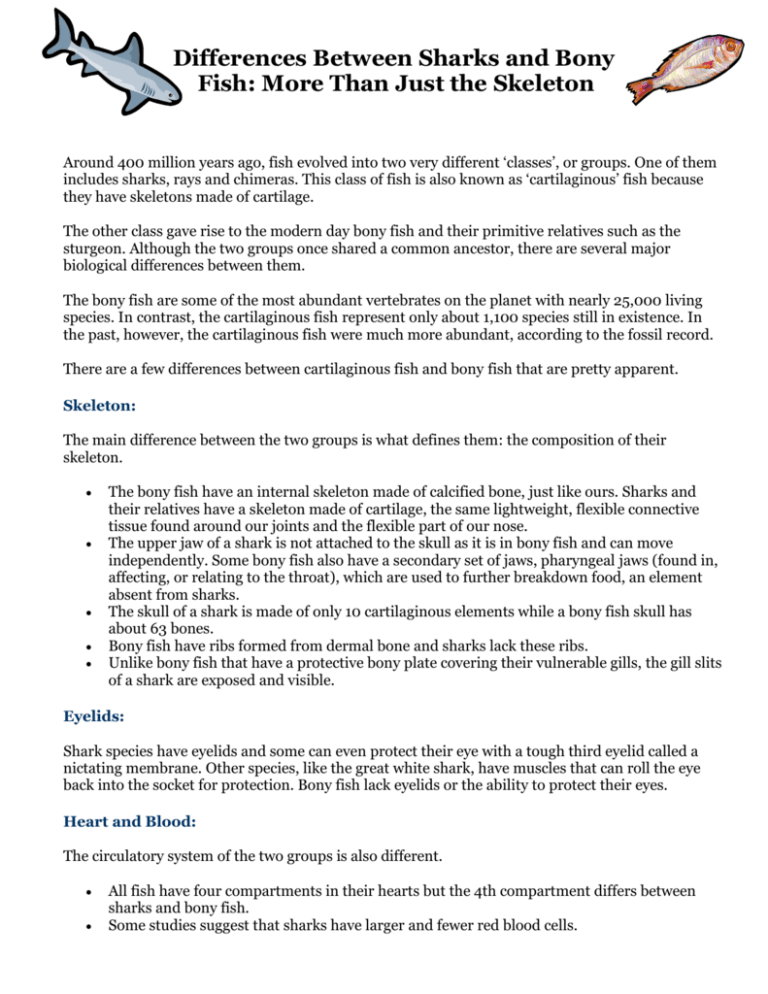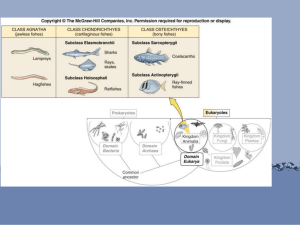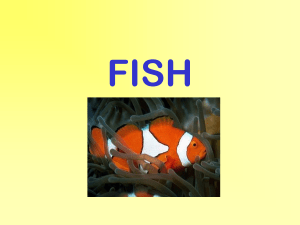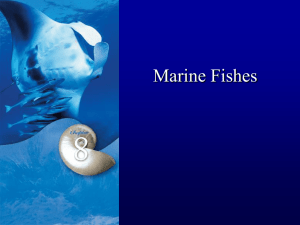Differences Between Sharks and Bony Fish
advertisement

Differences Between Sharks and Bony Fish: More Than Just the Skeleton Around 400 million years ago, fish evolved into two very different ‘classes’, or groups. One of them includes sharks, rays and chimeras. This class of fish is also known as ‘cartilaginous’ fish because they have skeletons made of cartilage. The other class gave rise to the modern day bony fish and their primitive relatives such as the sturgeon. Although the two groups once shared a common ancestor, there are several major biological differences between them. The bony fish are some of the most abundant vertebrates on the planet with nearly 25,000 living species. In contrast, the cartilaginous fish represent only about 1,100 species still in existence. In the past, however, the cartilaginous fish were much more abundant, according to the fossil record. There are a few differences between cartilaginous fish and bony fish that are pretty apparent. Skeleton: The main difference between the two groups is what defines them: the composition of their skeleton. The bony fish have an internal skeleton made of calcified bone, just like ours. Sharks and their relatives have a skeleton made of cartilage, the same lightweight, flexible connective tissue found around our joints and the flexible part of our nose. The upper jaw of a shark is not attached to the skull as it is in bony fish and can move independently. Some bony fish also have a secondary set of jaws, pharyngeal jaws (found in, affecting, or relating to the throat), which are used to further breakdown food, an element absent from sharks. The skull of a shark is made of only 10 cartilaginous elements while a bony fish skull has about 63 bones. Bony fish have ribs formed from dermal bone and sharks lack these ribs. Unlike bony fish that have a protective bony plate covering their vulnerable gills, the gill slits of a shark are exposed and visible. Eyelids: Shark species have eyelids and some can even protect their eye with a tough third eyelid called a nictating membrane. Other species, like the great white shark, have muscles that can roll the eye back into the socket for protection. Bony fish lack eyelids or the ability to protect their eyes. Heart and Blood: The circulatory system of the two groups is also different. All fish have four compartments in their hearts but the 4th compartment differs between sharks and bony fish. Some studies suggest that sharks have larger and fewer red blood cells. Sharks do not have bone so there is no bone marrow for the making of red blood cells. So red blood cells are made by organs that are exclusive to sharks. Sharks and bony fish have to deal with comparable amounts of acid levels in their blood after a period of exertion but sharks have the ability to maintain high hemoglobin content (oxygen-transporting substance in blood) in their blood and their blood oxygen carrying capacity is not affected. This means shark’s blood is better equipped to deliver oxygen to muscles more efficiently. External features: The outer design of sharks and bony fish is also contrasting. Shark skin is covered by dermal denticles, toothlike scales that are covered with enamel. This design is successful in minimizing drag and maximizing swimming efficiency. Bony fish are covered in flat scales that grow as the fish grows. The rings on these scales can be used to estimate age in bony fish, just as you would count the rings on a tree. However, dermal denticles do not grow with the shark so they can not be used in age estimation. Shark fins are stiff and lack the fine bony spines and muscle control found in bony fish. Flexible fins mean bony fish can swim forwards and backwards but sharks are stuck only going forward. Both sharks and bony fish have caudal fins, or tail fins with two lobes. The caudal fin of a shark has two lobes that are unequal in size and the vertebral column extends up into the top lobe. Bony fish caudal fins have symmetrical lobes that extend past the end of the vertebral column. Buoyancy: Because all fish live in a three dimensional environment, they have to control their position to keep from floating up to the surface or sinking to the bottom to the sea floor. This is known as neutral buoyancy, a state that SCUBA divers know well. Bony fish have an internal organ known as the swim bladder that helps them achieve neutral buoyancy by exchanging gases with the blood vessels. Sharks lack this structure but rely on a lighter cartilaginous skeleton, the low density oils in their relatively large livers, and even some gulp air from the surface to keep neutral. Life History: Sharks have developed a life history strategy that requires slow growth to a relatively large size. It takes a long time for most sharks to reach maturity. When they reproduce, they have low numbers of advanced offspring (shark pups are miniature versions of adult sharks and are on their own from birth) and repeat these reproductive events over a long life. Most bony fish demonstrate rapid growth, reach maturity younger, an increased ability to reproduce resulting in the creation of thousands of minuscule offspring that are scantily developed. Some bony fish have a single breeding event and then they die. The difference in these two strategies magnify why sharks and bony fish need to be managed in different ways. Bony fish on the fast track have the ability to replace itself in a population quickly but all of the characteristics listed above mean sharks take a lot longer. Copyright © 2011 Shark Savers Inc. All rights res









